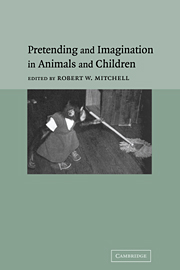Book contents
- Frontmatter
- Contents
- List of contributors
- Foreword by Sue Taylor Parker
- Preface and acknowledgments
- I Historical, developmental, and comparative overviews
- II Pretense and imagination in children
- 4 Language in pretense during the second year: what it can tell us about “pretending” in pretense and the “know-how” about the mind
- 5 A longitudinal and cross-sectional study of the emergence of the symbolic function in children between 15 and 19 months of age: pretend play, object permanence understanding, and self-recognition
- 6 Caregiver-child social pretend play: what transpires?
- 7 Just through the looking glass: children's understanding of pretense
- 8 Young children's understanding of pretense and other fictional mental states
- 9 Pretend play, metarepresentation and theory of mind
- 10 Replica toys, stories, and a functional theory of mind
- 11 Young children's animal-role pretend
- 12 Imaginary companions and elaborate fantasy in childhood: discontinuity with nonhuman animals
- III Pretense and imagination in primates
- IV Prospects
- References
- Author Index
- Subject Index
9 - Pretend play, metarepresentation and theory of mind
Published online by Cambridge University Press: 13 August 2009
- Frontmatter
- Contents
- List of contributors
- Foreword by Sue Taylor Parker
- Preface and acknowledgments
- I Historical, developmental, and comparative overviews
- II Pretense and imagination in children
- 4 Language in pretense during the second year: what it can tell us about “pretending” in pretense and the “know-how” about the mind
- 5 A longitudinal and cross-sectional study of the emergence of the symbolic function in children between 15 and 19 months of age: pretend play, object permanence understanding, and self-recognition
- 6 Caregiver-child social pretend play: what transpires?
- 7 Just through the looking glass: children's understanding of pretense
- 8 Young children's understanding of pretense and other fictional mental states
- 9 Pretend play, metarepresentation and theory of mind
- 10 Replica toys, stories, and a functional theory of mind
- 11 Young children's animal-role pretend
- 12 Imaginary companions and elaborate fantasy in childhood: discontinuity with nonhuman animals
- III Pretense and imagination in primates
- IV Prospects
- References
- Author Index
- Subject Index
Summary
In symbolic play, young children advance upon their cognitions about people, objects and actions and in this way construct increasingly sophisticated representations of the world.
(bornsteinet al., 1996, p. 2923)[O]ur intuition is that extensive fantasy experiences help children develop an understanding of mind.
(taylor & carlson, 1997, p. 452)Pretend play as a human characteristic
Fully developed pretend play, including role play and sociodramatic play, seems universal in all human societies and uniquely human, with only rudimentary pretence shown by some apes (Schwartzmann, 1978; Slaughter & Dombrowski, 1989; Smith, 1996). Cross-cultural variations exist in amount and type of pretence (Smilansky, 1968; Roopnarine, Johnson & Hooper, 1994), which appears dependent upon children's physical and cultural context. For example, among hunter-gatherers, children in mixed-age peer groups used sticks and pebbles to represent village huts and herding cows (Konner, 1976; Eibl-Eibesfeldt, 1989), and in the Marquesas Islands of Polynesia, children made mud bananas (Martini, 1994). Such symbolic object-use comprised half of the “fantasy play” episodes of the Marquesan children; the other half involved more complex scripts and roles, such as “‘ship’ play, ‘fishing,’ ‘hunting,’ and ‘preparing feasts’” (Martini, 1994, p. 84). These episodes “follow the same fantasy scripts from one performance to the next,” and often involve some imitation of adult actions.
The ubiquitousness of pretend play in human children suggests biological processes at work (Slaughter & Dombrowski, 1989; Harris, 1994), and raises the question of its biological function.
- Type
- Chapter
- Information
- Pretending and Imagination in Animals and Children , pp. 129 - 141Publisher: Cambridge University PressPrint publication year: 2002
- 5
- Cited by



